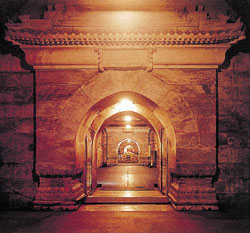 Dingling Tomb is the representative royal tomb of the Ming Dynasty tombs. Shisanling (13 royal tombs) of the foot of Dayu Mountain, Shisanling Region, Chang Ping County, Beijing. They are scattered in the basin of 40 square kilometers. Shisenling have 13 royal tombs of Emperors of the Ming Dynasty, generally called Royal Tombs of the Ming Dynasty.
Dingling Tomb is the representative royal tomb of the Ming Dynasty tombs. Shisanling (13 royal tombs) of the foot of Dayu Mountain, Shisanling Region, Chang Ping County, Beijing. They are scattered in the basin of 40 square kilometers. Shisenling have 13 royal tombs of Emperors of the Ming Dynasty, generally called Royal Tombs of the Ming Dynasty.
Dingling is the tomb of the thirteenth Emperor Shenzong (Zhuyijun) of the Ming Dynasty and his two Queens, Xiaoduan and Xiaojing.
The construction of Dingling Tomb started in the 12th year of Wenli of Shenzong's reign (AD1584) and was completed in the 18th year of Wanli (AD 1590). Buildings on the ground consist of Treasure City, Grand Mansion, Lingen Hall, two ground auxiliary halls, Lingen Gate, Ling Gate, Shenbo Oven, Dinvine Wardrobe, Divine Stock, Slaughter Pavilion and Wailuo City etc. At present, the Treasure City and Grand Mansion of the Ding Ling have been preserved fairly well.
The Grand Mansion is not only gallant and splendid, but also does not have a piece of wood and a nail. The rafters, brackets and inscribed board of the upper and lower caves are all inlaid with white stone sculptures and painted with colorful pictures which look like wood structure.
The Underground Palace Halls, a labyrinth palace building, were the first royal tomb excavated in accordance with plan in China. The labyrinth palace building consists of 5 underground halls, i.e. front, middle, back, left and right halls, with the total area 1195 square kilometers. There are seven stone gates in the five halls. The stone gates of the front, middle and back halls were most finely done with sculptured white marble. Every stone gate has two leaves, each of which is 3.3 m high and 1.8 m broad and weighs about 4 tons. On every facade of leaf, 81 nipple like nails and decorative beast head holding knocker in the mouth are sculptured. The back hall, the biggest one in the underground palace, is also called labyrinth room, which is the main part of the Underground Palace. It is 9.5 m high, 9.1 m broad and 30.1 m long, paved with polished piebald stones. On the front of the coffin platform, inner and outer coffins are laid with the Emperor Zhuyijun in the middle and two Queens, Xiaoduan and Xiaojing on two sides respectively.
Exhibition Room: The excavated articles of Ding Ling are 3000 odd in total which include a great number of gold, silver, jade, China wares. Textiles, crowns, belts and ornaments of emperor and queens, tin wares, posthumous tittle books and posthumous treasures etc.
Gold Crown: It was made of extremely thin gold threads, on which two dragons playing with pearl are inlaid, a skilful master piece with vivid posture. It is the first discovery among excavated articles in China.
Phoenix Crowns: Four Phoenix Crowns were excavated, on each of which 5 thousand odd pearls and 1 thousand odd precious stones have been inlaid. Phenix Crown was worn by queen on ceremonial occasions.
Dragon Crown: It was worn by Emperor Zhuyijun on grand ceremonial occasions, on which 12 dragon designs were embroidered.
Hundred Son Clothes were worn by Queen Xiaojing, on which double dragon longevity character was embroidered. All around the clothes, designs of pine, bamboo, plum, stone, peach, pear, banana, ganoderma, glossy and different flowers and grasses and picture of hundred sons were embroidered, vivid and lively, remarkably true to life.
(china.org.cn February 12, 2003)
|

